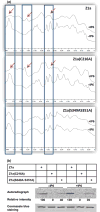Two serine residues in Pseudomonas syringae effector HopZ1a are required for acetyltransferase activity and association with the host co-factor
- PMID: 26103463
- PMCID: PMC4768790
- DOI: 10.1111/nph.13528
Two serine residues in Pseudomonas syringae effector HopZ1a are required for acetyltransferase activity and association with the host co-factor
Abstract
Gram-negative bacteria inject type III secreted effectors (T3SEs) into host cells to manipulate the immune response. The YopJ family effector HopZ1a produced by the plant pathogen Pseudomonas syringae possesses acetyltransferase activity and acetylates plant proteins to facilitate infection. Using mass spectrometry, we identified a threonine residue, T346, as the main autoacetylation site of HopZ1a. Two neighboring serine residues, S349 and S351, are required for the acetyltransferase activity of HopZ1a in vitro and are indispensable for the virulence function of HopZ1a in Arabidopsis thaliana. Using proton nuclear magnetic resonance (NMR), we observed a conformational change of HopZ1a in the presence of inositol hexakisphosphate (IP6), which acts as a eukaryotic co-factor and significantly enhances the acetyltransferase activity of several YopJ family effectors. S349 and S351 are required for IP6-binding-mediated conformational change of HopZ1a. S349 and S351 are located in a conserved region in the C-terminal domain of YopJ family effectors. Mutations of the corresponding serine(s) in two other effectors, HopZ3 of P. syringae and PopP2 of Ralstonia solanacerum, also abolished their acetyltransferase activity. These results suggest that, in addition to the highly conserved catalytic residues, YopJ family effectors also require conserved serine(s) in the C-terminal domain for their enzymatic activity.
Keywords: Arabidopsis thaliana; Pseudomonas syringae; YopJ family type III effectors; acetyltransferase; bacterial virulence; inositol hexakisphosphate (IP6); stomatal aperture.
© 2015 The Authors. New Phytologist © 2015 New Phytologist Trust.
Figures







References
-
- Berndsen CE, Denu JM. Assays for mechanistic investigations of protein/histone acetyltransferases. Methods. 2005;36:321–331. - PubMed
-
- Bohm H, Albert I, Fan L, Reinhard A, Nurnberger T. Immune receptor complexes at the plant cell surface. Current Opinion in Plant Biology. 2014;20:47–54. - PubMed
-
- Clough SJ, Bent AF. Floral dip: a simplified method for Agrobacterium-mediated transformation of Arabidopsis thaliana. Plant Journal. 1998;16:735–743. - PubMed
Publication types
MeSH terms
Substances
Grants and funding
LinkOut - more resources
Full Text Sources
Other Literature Sources

